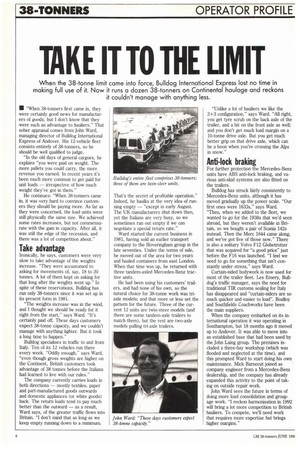TAKE 11 10 THE LI IT
Page 116

If you've noticed an error in this article please click here to report it so we can fix it.
When the 38-tonne limit came into force, Bulldog International Express lost no time in making full use of it. Now it runs a dozen 38-tonners on Continental haulage and reckons it couldn't manage with anything less.
• When 38-tonners first came in, they were certainly good news for manufacturers of goods; but I don't know that they were such an advantage to hauliers." That sober appraisal comes from John Ward, managing director of Bulldog International Express of Andover. His 12-vehicle fleet consists entirely of 38-toriners, so he should be well qualified to judge.
"In the old days of general cargoes, he explains "you were paid on weight. The more pallets you could carry, the more revenue you earned. In recent years it's been much more common to get paid for unit loads — irrespective of how much weight they've got in them."
He continues: "When 38-tonners came in, it was very hard to convince customers they should be paying more. As far as they were concerned, the load units were still physically the same size. We achieved some rates increases, but not commensurate with the gain in capacity. After all, it was still the edge of the recession, and there was a lot of competition about."
Take advantage
Ironically, he says, customers were very slow to take advantage of the weights increase. "They were accustomed to asking for movements of, say, 18 to 20 tonnes. A lot of them kept on asking for that long after the weights went up." In spite of these reservations, Bulldog has run only 38-tonners since it was set up in its present form in 1981.
"The weights increase was in the wind, and I thought we should be ready for it right from the start," says Ward. "It's certainly paid off. These days customers expect 38-tonne capacity, and we couldn't manage with anything lighter. But it took a long time to happen."
Bulldog specialises in traffic to and from Italy. Ten of its 12 vehicles run there every week. "Oddly enough," says Ward, "even though gross weights are higher on the Continent, British customers took advantage of 38 tonnes before the Italians had learned to live with our rules."
The company currently carries loads in both directions — mostly textiles, paper and part-manufactured goods outwards and domestic appliances (or white goods) back. The return loads tend to pay much better than the outward — as a result, Ward says, of the greater traffic flows into Britain. "I don't mind that as long as we keep empty running down to a minimum. That's the secret of profitable operation." Indeed, he baulks at the very idea of running empty — "except in early August. The UK manufacturers shut down then, yet the Italians are very busy, so we sometimes run out empty if we can negotiate a special return rate."
Ward started the current business in 1981, having sold an earlier transport company to the Hoveringhain group in the late seventies. Under the terms of sale, he moved out of the area for two years and hauled containers from east London. When that time was up, he returned with three tandem-axled Mercedes-Benz tractive units.
He had been using his customers' trailers, and had none of his own, so the natural choice for 38-tonne work was triaxle models; and that more or less set the pattern for the future. Three of the current 12 units are twin-steer models (and there are some tandem-axle trailers to match them), but the rest are two-axle models pulling tri-axle trailers. "Unlike a lot of hauliers we like the 2+3 configuration," says Ward. "All right, you get tyre scrub on the back axle of the trailer, and a bit on the front axle as well; and you don't get much load margin on a 10-tonne drive axle. But you get much better grip on that drive axle, which can be a boon when you're crossing the Alps in snow."
Anti-lock braking
For further protection the Mercedes-Benz units have ABS anti-lock braking, and various anti-skid systems are also fitted on the trailers.
Bulldog has struck fairly consistently to Mercedes-Benz units, although it has moved gradually up the power scale. "Our first ones were 1633s," says Ward. "Then, when we added to the fleet, we wanted to go for the 1938s that we'd seen abroad, but they weren't available in Britain, so we bought a pair of Scania 142s instead. Then the Mere 1644 came along, and we've got five of those now." There is also a solitary Volvo F12 Globetrotter that was acquired for "a good price" just before the F16 was launched. "I feel we need to go for something that isn't constantly under stress," says Ward.
Curtain-sided bodywork is now used for most of the trailer fleet. Les Emery, Bulldog's traffic manager, says the need for traditional TIR customs sealing for Italy has disappeared and "curtain-siders are so much quicker and easier to load". Boalloy and Southfields Coachworks have been the main suppliers.
When the company embarked on its international operation it was operating in Southampton, but 18 months ago it moved up to Andover. It was able to move into an established base that had been used by the John Laing group. The premises included a three-bay workshop (which was flooded and neglected at the time), and this prompted Ward to start doing his own maintenance. Mick Bamecut joined as company engineer from a Mercedes-Benz dealership, and the company has already expanded this activity to the point of taking on outside repair work.
John Ward sees the future in terms of doing more load consolidation and groupage work. "I reckon harmonisation in 1992 will bring a lot more competition to British hauliers. To compete, we'll need work that requires more expertise but brings higher margins."
























































































































































